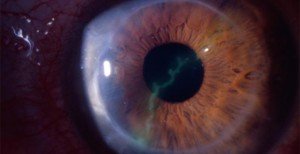
Differential Diagnoses
Recurrent corneal erosion
Herpes zoster ophthalmicus
Acanthamoeba keratitis
Contact lens–associated solution toxicity
Diagnosis
Herpes simplex virus keratitis
Learnings
Herpes simplex virus (HSV) infection is one of the most common viral infections of the eye and periocular skin. The majority of people older than 60 years will have seropositive findings for HSV type 1. Infection tends to follow the distribution of the trigeminal nerve. Most ocular infections are due to HSV type 1; however, HSV type 2 can also cause infection but is much less prevalent. Primary infection can range from a blistering rash on the face that may or may not involve the eye and orbit to an upper respiratory tract infection that goes undiagnosed as HSV. In a small percentage of the population, HSV can return to involve the eye at any time after the primary infection. This typically involves only one eye; it is very rare for HSV to involve both eyes. Recurrent bouts of HSV keratitis can cause permanent corneal scarring and loss of vision. Many people believe that stress, sunlight, and illness induce recurrence, but this has not been corroborated in scientific literature.
Patients often present with foreign-body sensation, light sensitivity, poor vision, and a red eye. Many times, patients will report a history of similar episodes in the past.
What to Look For
External examination may show herpetic lesions on the eyelids, pretarsal conjunctiva, or periorbital skin. Often, the conjunctiva will be injected and a lymph node may be palpable on the involved side. Corneal sensation is often reduced because of damage to the trigeminal nerve. Close inspection of the cornea may show dendritic branching lesions with terminal bulbs. The margins of these terminal bulbs will stain with rose bengal, and the center of the dendrite will stain with fluorescein. The dendrites can coalesce to form a geographic epithelial defect. Corneal scars may be present; they indicate previous episodes of keratitis. The corneal stroma is often of normal thickness but may be edematous with clumps of inflammatory cells on the endothelium (keratic precipitates). The anterior chamber may also show inflammatory cells. Close inspection of the iris may show areas of atrophy.
Acknowledgment: Image courtesy of Logical Images, Inc. (www.VisualDx.com/JUCM)
